
The Lamiaceae or Labiatae are a family of flowering plants commonly known as the mint, deadnettle or sage family. Many of the plants are aromatic in all parts and include widely used culinary herbs like basil, mint, rosemary, sage, savory, marjoram, oregano, hyssop, thyme, lavender, and perilla, as well as other medicinal herbs such as catnip, salvia, bee balm, wild dagga, and oriental motherwort. Some species are shrubs, trees, or, rarely, vines. Many members of the family are widely cultivated, not only for their aromatic qualities, but also their ease of cultivation, since they are readily propagated by stem cuttings. Besides those grown for their edible leaves, some are grown for decorative foliage. Others are grown for seed, such as Salvia hispanica (chia), or for their edible tubers, such as Plectranthus edulis, Plectranthus esculentus, Plectranthus rotundifolius, and Stachys affinis. Many are also grown ornamentally, notably coleus, Plectranthus, and many Salvia species and hybrids.

The Lake Wales Ridge National Wildlife Refuge is part of the United States National Wildlife Refuge (NWR) System, located in four separated areas on the Lake Wales Ridge east of US 27 between Davenport and Sebring Florida. The 1,194 acre (4.8 km2) refuge was established in 1990, to protect a host of plants and animals. It is also the first to be designated primarily for the preservation of endangered plants, and is not open to the general public. It contains a high proportion of remaining Florida scrub habitat. It is administered as part of the Merritt Island National Wildlife Refuge.

Monarda fistulosa, the wild bergamot or bee balm, is a wildflower in the mint family Lamiaceae, widespread and abundant as a native plant in much of North America. This plant, with showy summer-blooming pink to lavender flowers, is often used as a honey plant, medicinal plant, and garden ornamental. The species is quite variable, and several subspecies or varieties have been recognized within it.

Blephilia, the pagoda plant or wood mint, is a genus of three species of flowering plants in the family Lamiaceae. They are all herbaceous plants native to eastern North America. Blephilia are most often found in open areas, glades, and mesic forests. All species of Blephilia are considered threatened or endangered in some states.
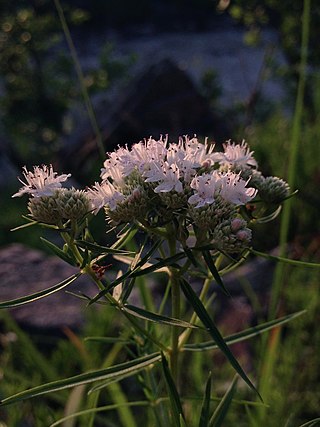
Pycnanthemum tenuifolium, the narrowleaf mountainmint, slender mountainmint, common horsemint or Virginia thyme, is a perennial herbaceous plant in the mint family, Lamiaceae. It is native to central and eastern North America.
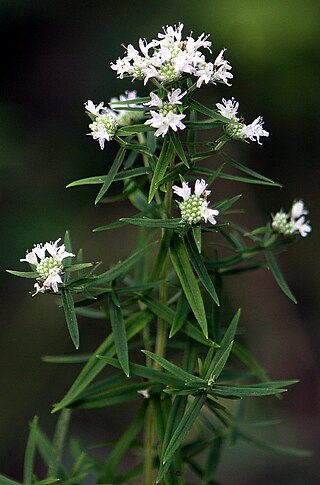
Pycnanthemum virginianum, the Virginia or common mountain-mint, is a plant in the mint family, Lamiaceae. It is a herbaceous plant with narrow, opposite, simple leaves, on wiry, green stems. The flowers are white with purplish spotting, borne in summer. Like most plants in the genus, the foliage has a strong mint fragrance when crushed or disturbed. It is native to the eastern United States and eastern Canada.
Hartwrightia is a genus of North American flowering plants in the tribe Eupatorieae of the family Asteraceae. The genus contains a single species, Hartwrightia floridana, native to the US states of Georgia and Florida. The species is sometimes referred to by the common name Florida hartwrightia.
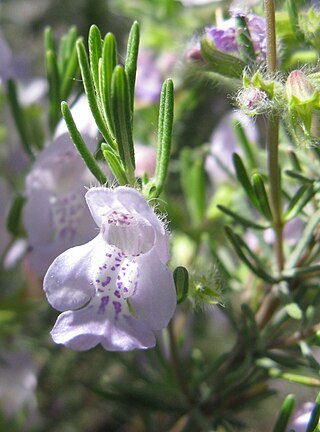
Conradina is a genus of flowering plants in the mint family, Lamiaceae. Its common name is false rosemary, or rarely, short leaf rosemary. There are 7 species of Conradina, all native to the southeastern United States. Conradina verticillata grows on the Cumberland Plateau in Kentucky and Tennessee. The other five grow mainly in Florida. All of the species are closely related and there is some doubt about whether they are all separate. Most species occupy xeric habitats with well-drained soils composed of white sand. The genus Conradina was established by Asa Gray in 1870. It was named for the American botanist Solomon White Conrad.

Pycnanthemum is a genus of herbaceous plants in the mint family (Lamiaceae). Species in this genus are often referred to as "mountain mints" and they often have a minty or thyme-like aroma when crushed. All species of Pycnanthemum are native to the United States and Canada. The center of diversity for the genus is North Carolina with 13 of the 20 species having been collected therein. Nineteen of the 20 species of Pycnanthemum occur in the Eastern US and Canada, and one disjunct species occurs in California and Oregon.
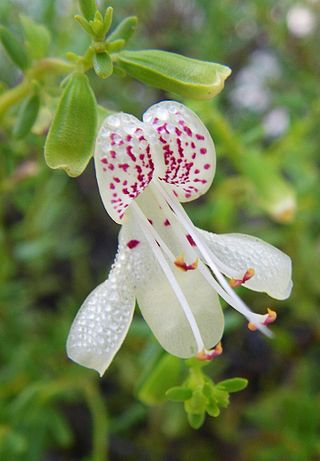
Dicerandra christmanii is a rare species of flowering plant in the mint family known by the common names Garrett's mint, yellow scrub balm, and Lake Wales balm. It is endemic to Highlands County, Florida, in the United States, where it is known from only four sites on the Lake Wales Ridge. All are contained within a tract of land measuring 6 kilometers by 3 kilometers. The plant is steadily declining due to the destruction and degradation of its habitat, and only one of the four occurrences is on protected land. It is a federally listed endangered species.
Dicerandra cornutissima is a rare species of flowering plant in the mint family known by the common name longspurred mint, longspurred balm, and Robin's mint. It is endemic to Florida in the United States. It is found in Marion County, and possibly Sumter County, but it may have been totally extirpated from the latter. There are 15 known occurrences remaining. The plant was federally listed as an endangered species in 1985.

Dicerandra frutescens is a rare species of flowering plant in the mint family known by the common names scrub mint and scrub balm. It is endemic to Highlands County, Florida, where it is known only from the Lake Wales Ridge. Its habitat is quickly being lost as it is converted to residential and agricultural use. It was federally listed as an endangered species of the United States in 1985.

Dicerandra is a genus of flowering plants in the mint family. Dicerandra comprises 11 species: six perennial and five annual species. The perennials have narrow ranges in Central Florida with small population sizes and only occur on ancient dune ridges along the Lake Wales Ridge or the Atlantic coastal ridge; the annual species occur more broadly on sandhill habitats to the north. The perennials’ habitat has been severely fragmented due to human development over the past century. As a result, all perennial species except one are listed as federally endangered. Annual species of the clade have large ranges when compared to perennial members, with distributions of annuals ranging for hundreds of miles from the Panhandle of Florida to southeastern Georgia, with the exception of Dicerandra radfordiana which is endemic to two sites along the Altamaha river. The genus is characterized by hornlike spurs on their anthers.

Blephilia hirsuta is an herbaceous perennial of the mint family Lamiaceae native to eastern North America. It is commonly called hairy wood-mint or hairy pagoda plant.

Mentheae is the largest tribe of plants in the family Lamiaceae. It includes herbs such as sage, hyssop, mint, bee balm and thyme.
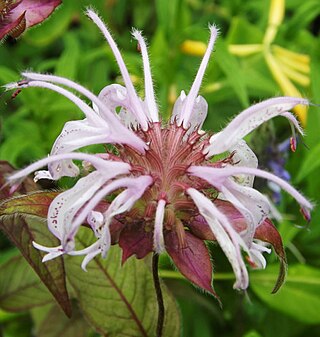
Monarda bradburiana, the eastern beebalm or Bradbury's beebalm, is a species of perennial flowering plant in the mint family, Lamiaceae, that is native to much of the southeastern United States.
Dicerandra linearifolia, or coastal plain balm, is a species of Dicerandra native to the Southeastern Coastal Plain, United States.
Dicerandra modesta is a species of Dicerandra endemic to the Lake Wales Ridge in Central Florida. It is commonly known as blushing scrub balm. It is a listed state and federal endangered species. It is known only from a few populations in Polk County, Florida. It grows in scrub and sand hills.
Dicerandra odoratissima, commonly known as the rose balm, is a species of Dicerandra native to the Southeastern Coastal Plain, with a geographic range that extends from eastern Georgia to southern South Carolina. Kral (1982) originally suggested that this species was so distinct from the remaining members of the genus that it should be placed in a separate section or a distinct genus. Today, D. odoratissima and its close relative D. radfordiana are members of the Lecontea clade.
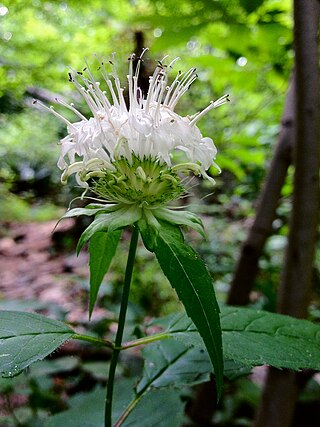
Monarda clinopodia, commonly known as white bergamot, basil bee balm or white bee balm, is a perennial wildflower in the mint family, Lamiaceae. This species is native to North America, ranging north from New York, west to Missouri, and south to Georgia and Alabama. M. clinopodia has also been introduced into Vermont and Massachusetts.













